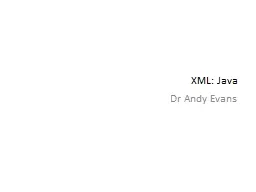/


Dr Andy Evans Java and XML Couple of things we might want to do Parsewrite data as XML Load and save objects as XML Well mainly discuss JAXP Java API for XML Processing Built in Increasingly core classes have XML reading and writing methods ID: 352226
Download Presentation The PPT/PDF document "XML: Java" is the property of its rightful owner. Permission is granted to download and print the materials on this web site for personal, non-commercial use only, and to display it on your personal computer provided you do not modify the materials and that you retain all copyright notices contained in the materials. By downloading content from our website, you accept the terms of this agreement.
Slide1
XML: Java
Dr Andy EvansSlide2
Java and XML
Couple of things we might want to do:
Parse/write data as XML.
Load and save objects as XML.
We’ll mainly discuss JAXP (Java API for XML Processing).Slide3
Built in
Increasingly core classes have XML reading and writing methods.
Properties:
loadFromXML
() and
storeToXML
()
<?xml version="1.0" encoding="UTF-8
"?>
<!
ELEMENT properties ( comment?, entry* ) >
<!
ATTLIST properties version CDATA #FIXED "1.0">
<!
ELEMENT comment (#PCDATA) >
<!
ELEMENT entry (#PCDATA) >
<!
ATTLIST entry key CDATA #
REQUIRED>Slide4
JAXP XML Parsing
Two major choices:
Document Object Model (DOM) / Tree-based Parsing:
The whole document is read in and processed into a tree-structure that you can then navigate around.
The whole document is loaded into memory.
Stream based Parsing:
The document is read in one element at a time, and you are given the attributes of each element.
The document is not stored in memory.Slide5
Stream-based parsing
Stream-based Parsing divided into:
Push-Parsing / Event-based Parsing:
The whole stream is read and as an element appears in a stream, a relevant method is called.
The programmer has no control on the in-streaming.
Pull-Parsing:
The programmer asks for the next element in the XML and can then farm it off for processing.
The programmer has complete control over the rate of movement through the XML.
Trade off control and efficiency.Slide6
DOM-based parsing
javax.xml.parsers
G
et a parser and set it up with an
InputStream
.
Once it has read the XML you can get it as a
Document
.
Once you have a
Document
, it is possible with methods like
getElement
and
createElement
to read and write to the XML stored in the program.
The key class is
DocumentBuilder
.
This is gained from a
DocumentBuilderFactory
which has various methods to set up the parser, including
setValidating
, if you wish to ensure the XML is well formed. Slide7
SAX (Simple API for XML)
Push/event-based parsing
javax.xml.parsers
B
uild a handler that implements a set of interfaces, and register the handler with a parser (connecting the parser to an
InputStream
at the same time).
When the parser hits an element it calls the relevant method.
Key classes are
SAXParser
and
DefaultHandler
.
The former is gained from a
SAXParserFactory
which has various methods to set up the parser, including
setValidating
, if you wish to ensure the XML is well formed.Slide8
Writing DOM/SAX
TrAX
(Transformation API For XML [
Xalan
?]):
javax.xml.transform
API for transforming between XML flavours using XSLT.
http://www.onjava.com/pub/a/onjava/2001/07/02/trax.html
TrAX
is important even if you aren't interested in transforming XML, as it offers the option for transforming SAX and DOM objects to streams for writing/serializing to text files.
The key classes are the different implementations of
Source
along with
StreamResult
used with a
Transformer
.
http://www.cafeconleche.org/books/xmljava/chapters/ch05s05.htmlSlide9
StAX (Streaming API for XML)
Pull-parsing
javax.xml.stream
You ask a parser for each new element, and then request its attributes.
The key classes are
XMLStreamReader
&
XMLStreamWriter
.
Though there are also slightly more event-based versions as well:
http://
docs.oracle.com/cd/E17802_01/webservices/webservices/docs/1.6/tutorial/doc/SJSXP3.html
The parsers are gained from a
XMLInputFactory
while the writer is gained from a
XMLOutputFactory
:
http://docs.oracle.com/cd/E17802_01/webservices/webservices/docs/1.6/tutorial/doc/SJSXP.html#wp69937Slide10
Marshalling/Binding
Saving of java Objects as XML in a text file for later
unmarshalling
back to working Java objects.
This is a bit like serialisation (the saving of objects to binary files) but somewhat more constrained.
Binding: automatically processing of XML into classes that can have data read into their objects.
JAXB (Java Architecture for XML Binding:
javax.xml.bind
)
Write schema.
Convert scheme to class (xjc.exe) and fill with code.
Use
ObjectFactory
to generate objects, then fill using
accessor
/
mutator
methods.
Marshall.
Slide11
Helpful links
Processing XML with Java
http://www.cafeconleche.org/books/xmljava/
XML and Java for Scientists/Engineers
http://www.isr.umd.edu/~austin/ence489c.d/xml.html
The Java Web Services Tutorial
http://java.sun.com/webservices/docs/2.0/tutorial/doc/